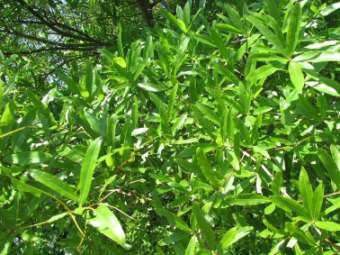 Willow Oak
Willow Oak
(Quercus phellos L.)
|
Classification |
| Kingdom: |
Plantae |
| Division: |
Magnoliophyta |
| Class: |
Magnoliopsida |
| Order: |
Fagales |
| Family: |
Fagaceae |
| Genus: |
Quercus |
| Species: |
phellos |
 Characteristics: The Willow Oak has a conical or rounded crown with branches ending in very slender, pin-like, twigs with willow-like leaves. It can reach heights of 50 to 80 feet with trunk diameters ranging from 1 to 2 feet. The narrow, oblong leaves have bristles on the end; the edges are straight or only slightly wavy. The bark of younger trees is dark gray and smooth, becoming blackish, irregular, and rough as the tree ages. Brown acorns are produced in the fall every second year.
Characteristics: The Willow Oak has a conical or rounded crown with branches ending in very slender, pin-like, twigs with willow-like leaves. It can reach heights of 50 to 80 feet with trunk diameters ranging from 1 to 2 feet. The narrow, oblong leaves have bristles on the end; the edges are straight or only slightly wavy. The bark of younger trees is dark gray and smooth, becoming blackish, irregular, and rough as the tree ages. Brown acorns are produced in the fall every second year.
Habitat: Willow Oaks grow best in moist sand, silt, clay or gravel soil in lowlands, mainly floodplains of streams. They can sometimes be found in pure stands, but often grow in mixed hardwood forests.
Range: The Willow Oak is found throughout the eastern and southern United States from New Jersey to Florida and even into Texas and Illinois.
Native American Uses: Some tribes used decoction of wood or bark as a bath for aches and pains. In addition the acorns were utilized as food and wood was used for crafts.
Colonial Uses: Acorns sometimes served as a substitute for flour and, when roasted with chicory, a coffee substitute.
Modern Uses: A popular street and shade tree, the Willow Oak often becomes too big for the area in which it was planted which can cause structural damage to streets or nearby houses.